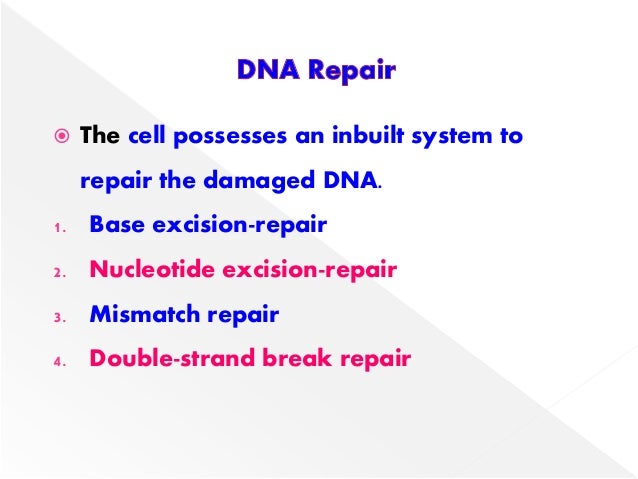
After the discovery of DNA there were many problems including DNA damage so scientists identified the DNA. DNA REPAIR MECHANISM PRAVEENA PRASAD. DNA repair is a collection of processes by which a cell identifies and corrects damage to the DNA molecules that encode its genome. Excision): Damage is cut by one of the series of nucleases each specialized for a type of DNA damage. Re-synthesis): Original DNA sequence is restored by a repair DNA polymerase.

DNA glycosylase recognizes Specific Damaged base 2. AP endonuclease cleaves Backbone 4. DNA Pol removes abasic site 5. DNA Repair Mechanisms PPT (Introduction to DNA Repair Mechanism PPT) What is DNA Repair ? The large gap produced in the DNA helix is then repaired by DNA polymerase I and sealed by DNA ligase (Fig. 1 B). So far there are six different types of DNA repair mechanisms known to science. Photoreactivation: a light depended DNA repair mechanism which removes thymine dimers (2). SOS repair system is an error-prone mechanism , as it works without a DNA template.
An organism initiates the production of activator protein (RecA), which in the dissociation of LexA repressor and activates the SOS inducer proteins, is a process that refers as “SOS response system”. Basic DNA repair mechanism 1st. Direct reversal of DNA damage is a mechanism of repair that does not require a template and is applied to two main types of damage. UV light induces the. Increased DNA repair capacity in cancer cells that may remove therapy-induced DNA lesions before they become toxic is a major mechanism for development of resistance to therapy.
Inhibition of DNA repair in tumors may be an effective approach to enhance the efficacy of DNA damage-based therapy of cancer. DNA repair , any of several mechanisms by which a cell maintains the integrity of its genetic code. DNA repair ensures the survival of a species by enabling parental DNA to be inherited as faithfully as possible by offspring.
It also preserves the health of an individual. In human cells, both norm. Damage to cellular DNA is involved in mutagenesis and the development of cancer. DNA Damage and Repair Mechanisms.

The DNA in a human cell undergoes several thousand to a million damaging events per day, generated by both external (exogenous) and internal metabolic (endogenous) processes. Living organisms are continuously exposed to a myriad of DNA damaging agents that can impact health and modulate disease-states. However, robust DNA repair and damage-bypass mechanisms faithfully protect the DNA by either removing or tolerating the damage to ensure an overall survival. Slipped strand mispairing (SSM), (also known as replication slippage), is a mutation process which occurs during DNA replication. It involves denaturation and displacement of the DNA strands, resulting in mispairing of the complementary bases.
The Error-Prone (SOS) Repair Mechanism The error-prone repair mechanism involves DNA pol. III and other gene products encoded by umuCD. The UmuCD proteins are produced in times of dire emergency and instruct DNA pol.

III to insert any bases opposite the tymine dimers, as the DNA damage would otherwise be lethal. Recombination repair (daughter-strand gap repair ): When excision repair mechanisms fails, this mechanism , is required to repair errors. This mechanisms , operates in the viral chromosome in host cell whose DNA is damaged. Estimated rates of DNA damage per human cell per day: “Mutation is rare because of repair ” Over 2human genes known to be involved in DNA repair Major mammalian DNA repair pathways: 1. The fact that some enzymes participate both in repair and in recombination accounts for the fact that many recombination‐deficient mutant bacteria are also highly sensitive to ultraviolet light.
The rare human genetic disease xeroderma pigmentosum is due to a deficiency in one of the many components of the DNA repair system. Mechanisms to correct errors during DNA replication and to repair DNA damage over the cell's lifetime. Base excision repair.
No comments:
Post a Comment
Note: Only a member of this blog may post a comment.